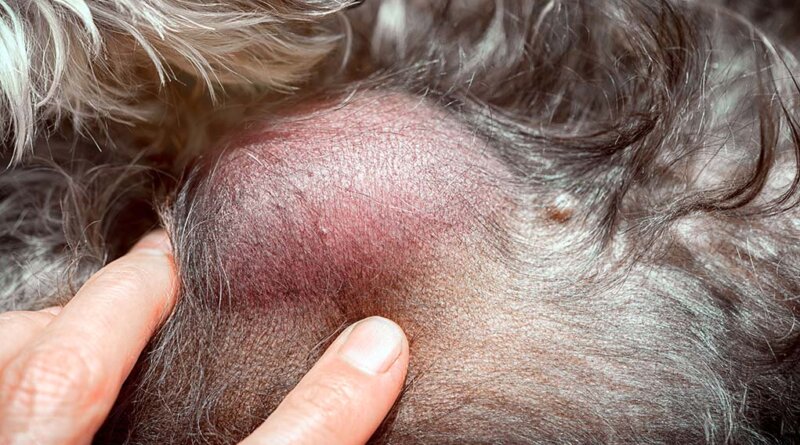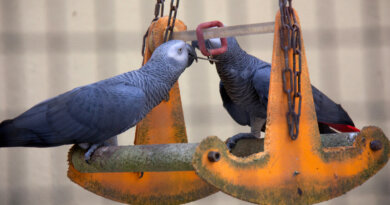A Science-based Guide (Types, Treatments, Survival)
Cancer is the leading cause of death in dogs, but not all cancers are the same.
There are many different types of cancer and some are more common than others.
And while sarcoma in dogs is not that common (it’s responsible for approx. 10–15% of malignant tumors in dogs), it can be as dangerous as the worst of them (1).
Some breeds are more predisposed to this.
Cancerous growth (neoplasia) was responsible for the death in 71 out of 80 dog breeds.
A dog’s weight and height directly correlate to how likely they are to die from cancerous growths like sarcoma, and large breeds are at the highest risk (2).

Dog breeds most likely to die from neoplasia (3): Bernese Mountain Dog (55%), Golden Retriever (50%), Scottish Terrier (48%), Bouvier des Flandres (47%), Boxer (44%), Bullmastiff (44%), Irish Setter (41%), and Airedale Terrier (40%).
Dog breeds least likely to die from neoplasia (3): Maltese (9%), Dachsund (9%), Pekingese (8%), Pomeranian (8%), Chihuahua (8%), Miniature Dachsund (6%) and Miniature Pinscher (4%).
What Is Sarcoma in Dogs?
Sarcoma is a malignant, cancerous growth or tumor which can appear inside the dog or on their skin.
This type of cancer is rare, and studies estimated that in the United States the number of canine sarcomas occurring annually is 7700 to 31,800, based on the overall canine cancer cases of 99.3–272.1 per 100,000 dogs (4).
This cancer appears in a different kind of tissue compared to other cancers, namely in connective tissues like bones, muscles, nerves, cartilages, tendons, and blood vessels.
While there are around 50 different types of sarcoma, for the most part they are classified into two main groups: soft tissue sarcoma and bone sarcoma (osteosarcoma).
Soft tissue sarcoma is more common, and it represents 80% of cases, while bone sarcoma represents 20% of cases of malignant tumors in dogs (5, 6).
How Long Can a Dog Live With a Sarcoma?
In low-grade soft tissue sarcoma, dogs have a good probability of surviving between 2-and 4 years. In high-grade tumors, the survival period is much lower, 12 months or less despite going to chemotherapy. That life expectancy increases when the vet surgically removes the tumor.
What Are the Symptoms of Sarcoma in Dogs?
When sarcomas start to grow in different areas of the body, the dog will show symptoms of muscle atrophy, limping, no desire to play or exercise, and possible behavior problems.
Soft Tissue Sarcoma in Dogs
Soft tissue sarcoma is a type of cancer that originates in the connective tissues of a dog’s body (7, 8, 9).
Since it can grow in any part of dog body’s soft tissue, there are many different types of soft tissue sarcoma in dogs: fibrosarcoma, rhabdomyosarcoma, liposarcoma, neurofibrosarcoma, malignant fibrous histiocytoma, hemangiosarcoma, and more (10, 11).
The main location and incidence of sarcomas in dogs in the U.S. (5, 6, 10, 11):
| Tumor type | Tissue location | % of dog cancersa | Estimated annual incidence in USb |
|---|---|---|---|
| Hemangiosarcoma | Spleen, heart, liver, subcutis, dermis | 2.8%–5.0% | 2156–10,600 |
| Fibrosarcoma | Subcutis and oral cavity | 3.0%–3.4% | 2310–7208 |
| Peripheral nerve sheath tumor | Subcutis | 1.7%–5.6% | 1309–11,872 |
| Myxosarcoma | Subcutis | 0.2% | 154–424 |
| Liposarcoma | Subcutis | 0.2%–0.3% | 154–636 |
| Rhabdomyosarcoma | Tongue, larynx, heart, urinary bladder | 0.1% | 77–212 |
| Leiomyosarcoma | GI tract, liver, vagina, subcutis | 0.1% | 77–212 |
| Synovial cell sarcoma | Joints | ||
| Lymphangiosarcoma | Subcutis, often trunk | 0.1% | 77–212 |
| Histiocytic sarcoma | Joints, liver, spleen, lung, subcutis | 4.0% | 3080–8480 |
| Osteosarcoma | Appendicular/axial skeleton (85%/15%) | 0.9%–2.8% | 693–5936 |
| Chondrosarcoma | Nasal cavity, ribs, extremities | 0.3%–0.4% | 231–848 |
These tumors are usually considered collectively by oncologists because they have similar biological behavior.
However, they don’t all have the same histologic grade, which is an evaluation of how aggressive a tumor is and how likely it is to metastasize to other parts of a dog’s body.
Some sarcomas in dogs, like hemangiosarcoma, rhabdomyosarcoma and histiocytic sarcoma, are more aggressive than the rest of the group.
Below, we’ll take a look at the four common types of soft tissue sarcomas in dogs.
1. Fibrosarcoma in dogs
Fibrosarcoma is caused by an uncontrolled overgrowth of connective tissue cells called fibroblasts.
Fibrosarcoma is a very common type of tumor in dogs, and it is usually not too aggressive, and metastasis was observed in approx. 20% of cases (12).
There are a few different types of fibrosarcoma tumors, but they all mostly appear in the connective tissue of a dog’s skin and beneath the skin (13).
In most cases, fibrosarcomas can be found on the limbs and the trunk of a dog’s body.
They also commonly occur in the dog’s mouth or nasal cavity.
Older research based on retrospective studies claimed that fibrosarcoma has the worst prognosis for dogs among all other types of sarcomas.
However, these studies didn’t have a proper analysis of survival times nor adequate case numbers for such conclusions, thus their prognosis assessment cannot be used as hard evidence (14, 15).
While several retrospective studies have suggested that FSA may carry a worse prognosis compared to other STS types, these studies lack proper survival analyses and adequate case numbers to draw significant conclusions on the prognostic significance of histologic type
Large dog breeds are at greater risk of having fibrosarcoma, especially Doberman Pinschers, Rottweilers, Golden Retrievers, and Gordon Setters (16).
Fibrosarcoma is more common in middle-aged and older dogs, typically affecting dogs older than 10 years.
Symptoms
Symptoms of fibrosarcoma can vary, depending on the size of the tumor, location, and extent of the tumor.
Generally, fibrosarcoma usually appears as a single firm lump or bump on a dog’s skin, or under their skin.
This lump can sometimes ulcerate and bleed, or even become infected.
There can also be more than one lump, all of them likely to be found in the same area.
This lump or lumps can cause pain to the dog, and make your pet less sociable.
The dog may also lose appetite and refuse to be touched.
If a dog’s leg is affected, they may have problems getting up or lying down.
Lameness can also show as a symptom, which may later turn into a complete inability to walk.
If a dog’s nasal cavity is affected, you may notice mucus discharge from your dog’s nose or even from their eyes.
A dog may also sneeze or snore a lot, or get nosebleeds.
If their mouth is affected, a dog may struggle to chew or swallow; there can also be excessive drooling or bleeding from the mouth.
Oral and nasal tumors can also cause bad breath (halitosis), loose teeth, or facial deformity.
2. Liposarcoma
This is another type of soft tissue sarcoma in dogs.
While it’s common in humans, it’s a very rare type of malignant tumor in dogs that develops in fat cells (17, 18, 19).
It’s generally found in subcutaneous spots, particularly along the extremities.
However, it can also occur in a dog’s bones or abdominal cavities.
Liposarcoma in dogs should not be mistaken for lipoma, which is a benign tumor.
However, liposarcomas are not that aggressive and are mostly locally invasive with a low potential to metastasize to distant organs, especially if it is caught in the early stages.
This type of cancer most commonly affects older dogs.
Symptoms
Some liposarcomas appear as bumps or nodes on a dog’s skin, especially in loose skin around their groin and neck.
They can feel hard when you touch them or give in slightly when you squeeze them.
You may also notice abdominal lumps, dropping of your dog’s stomach, or swelling on one side of the abdomen, although that only occurs in rare cases.
Liposarcoma can lead to persistent joint pain, which is often mistaken for arthritis since liposarcomas usually occur in older dogs.
You may also spot a swelling on your dog’s leg.
3. Rhabdomyosarcoma
This is a malignant, rare, and very aggressive tumor that affects dogs of all ages.
This type is currently one of the least studied in dogs, and very little scientific literature is available to draw definite conclusions (20, 21).
Rhabdomyosarcoma in dogs develops in striated muscles of the cardiac and skeletal musculature in adult dogs, while in younger dogs it arises from embryonic stem cells.
These tumors more often affect medium to large breeds.
This type of tumor usually develops in the tongue, larynx or a dog’s heart.
However, it can easily metastasize to other areas, most commonly a dog’s lungs, spleen, liver, kidneys, and adrenal glands.
Symptoms
Some common signs of rhabdomyosarcoma in dogs include swelling and the presence of lesions or masses, which are often firm and fixed.
These lesions can become infected or ulcerated, and commonly appear on the trunk, extremities, or oral cavities.
Symptoms can vary depending on the location of the tumor. For example, if the tumor appears in the larynx (voice box), it can cause difficulty breathing.
Oral tumors often lead to bad breath or excess salivation in dogs.
And if the tumor spreads to other organs, symptoms are bound to be more noticeable and varied.
4. Hemangiosarcoma
Unlike liposarcoma or rhabdomyosarcoma, canine hemangiosarcoma is a more common type of soft tissue sarcoma in dogs, with prevalence rates estimated to be similar to fibrosarcoma (22, 23, 24, 25).
It’s similar to angiosarcoma in humans (26).
This is a form of malignant tumor that develops in the cells that line the blood vessels of various tissues of a canine’s body (27).
Hemangiosarcoma in dogs most often appears on the spleen, liver, right heart base or skin and subcutis (28, 29, 30, 31).
However, some varieties of it can appear on a dog’s skin, under it, or in other locations.
This type of cancer is more common in medium to large breeds, especially in Golden Retrievers, Labrador Retrievers, German Shepherds, and Boxers (32, 33, 34, 35).
It is also more likely to develop in middle-aged or senior dogs.
Hemangiosarcoma is a very aggressive cancer that often spreads rapidly to other organs.
Symptoms
Unfortunately, dogs with hemangiosarcoma often don’t show any clinical signs before the tumor spreads and becomes too large to treat.
In most cases, the first sign is internal bleeding when the tumor ruptures.
This can manifest in dogs as weakness, difficulty breathing, collapse or even sudden death.
There is a chance that hemangiosarcoma in dogs can be identified early through X-rays, ultrasound, or abdominal palpitation but even with early detection, the prognosis for this type of canine cancer is poor.
How Is Soft Tissue Sarcoma in Dogs Diagnosed?
Soft tissue sarcoma in dogs is commonly first spotted during a physical examination, especially if there is a lump or a bump (36, 37).
If your vet finds it concerning, they will ask whether you have noticed any symptoms and then review your dog’s medical history.
The vet will then proceed with diagnostic imaging and microscopic examination of tumor cells if they think that’s necessary.
This can be done by tissue biopsy or fine-needle aspiration (FNA).
In most cases, your vet will go with tissue biopsy since FNA is not a very effective method for diagnosing soft tissue tumors in dogs.
How Is Dog Soft Tissue Sarcoma Treated?
Soft tissue sarcomas are treated like any other cancer: surgery, radiotherapy and/or chemotherapy.
In most cases, surgery is the first and most effective option for canine soft tissue sarcomas, and it’s also good for preventing cancer from reoccurring (38, 39, 40, 41).
If all of the tumor tissue is successfully removed after surgery, other treatments may not be necessary.
However, if that is not the case, a second surgery may be needed to achieve this (42, 43).
Radiation therapy may also be used after surgery to remove the remaining tumor cells.
It was shown to further decrease chances of cancer’s recurrence (44, 45, 46).
It’s also commonly used in cases where aggressive surgery is not a viable option for various reasons.
Radiation therapy can also help with very large tumors, either by slowing down further growth or making the tumor regress to the size that will allow surgical removal.
Stereotactic radiation (SRS/SRT) is an effective alternative to surgery (47, 48, 49).
Chemotherapy is sometimes used for high-grade sarcomas (50). Chemo can delay or even prevent the further spread of cancer to other areas of a dog’s body (51).
Post-surgical treatment and management with regular administration of oral cyclophosphamide alongside non-steroidal anti-inflammatory drug called piroxicam was shown to decrease the likelihood of sarcoma in dogs (52).
What’s the Prognosis for Dogs with Soft Tissue Sarcomas?
The prognosis for soft tissue sarcoma in dogs depends on the size, location and grade of the tumor.
Tumors with low to intermediate grade have a great long-term prognosis, particularly if they can be completely removed with surgery.
On the other hand, the long-term prognosis for high-grade sarcomas is not that good and often means that the dog doesn’t have much time left, commonly six months to a year.
Radiation therapy shown similar results, with median survival times estimated at approx. 3-6 months (53, 54, 55).
Bone Sarcoma in Dogs (Osteosarcoma)
Next to the soft tissue sarcomas, the other common type of sarcoma in dogs is bone sarcoma (osteosarcoma).
It’s the most prevalent bone tumor in dogs (56, 57), with chondrosarcoma being a far second and much less prevalent type of bone cancer (58).
Osteosarcoma is a very aggressive malignant tumor that primarily develops in a dog’s bone tissue and it is extremely similar to osteosarcoma in humans (59, 60, 61, 62, 63).
Osteosarcoma arises from the abnormal production of osteoblasts and osteoclasts, which are cells that create and break the bone down.
The most commonly affected bones are those in limbs, where osteosarcoma shows 3-4 times more often than elsewhere (64, 65, 66).
While more rare, it can also appear in other bones like hips, pelvis or jaw. Studies also found lung to be a very common place of spread (67).
In some rare cases it can also affect tissue unrelated to bones, like the spleen, liver, kidneys and mammary glands (this is called extraskeletal osteosarcoma).
This type of bone cancer is more common in giant and large breeds, especially Boxers, Golden and Labrador Retrievers, German Shepherds, Doberman Pinschers, Greyhounds, Saint Bernards, Great Danes, Rottweilers, Irish Setters, Scottish Deerhounds, and Irish Wolfhounds.
While breed’s genetic predisposition to bone cancer is the main factor, studies also found that another correlation is breed’s size, with height playing a bigger role than weight (68).
Symptoms
Symptoms of osteosarcoma in dogs are usually subtle and not easy to spot.
However, you may notice swelling or a mass growth on your dog’s body, as well as painful inflammation in the area where the tumor may arise later or already have grown.
Lameness, joint and bone pain are also common signs of osteosarcoma.
Sometimes, your dog may also appear tired or even have anorexia.
How Is Osteosarcoma in Dogs Diagnosed?
If you notice lameness of a limb in your pet, especially if that’s accompanied by swelling that seems warm to the touch, take your dog to the vet to determine the cause, since it can be caused by osteosarcoma.
The vet will take X-rays of the affected region. If there is part of the bone that appears missing due to the loss of bone tissue, or if the vet notices a fracture, which can appear if the bone is too weak, they will order additional tests.
The test will include fine needle aspiration, where the vet will suction a sample of affected cells with a small needle.
In some cases, bone biopsy may also be necessary to ensure an accurate diagnosis.
How Is Dog Osteosarcoma Treated?
If there is no evidence that the tumor has spread through a dog’s body, your vet will recommend surgery to remove the tumor (69).
This can either be limb-sparing surgery or amputation of the affected limb (70, 71).
While this may be unsettling for you, keep in mind that dogs are able to get used to life without a limb much easier than humans and usually do well after amputation.
Similar to soft tissue sarcoma in dogs, stereotactic radiation can be an effective alternative to amputation in dogs for cases where osteosarcoma hasn’t killed too much of the bone.
In addition to surgery, chemotherapy is almost always advised to control the disease and prevent or slow down its metastasizing.
What’s the Prognosis for Osteosarcoma in Dogs?
Unfortunately, since osteosarcoma is a very aggressive type of cancer in dogs, the prognosis is rarely good.
The median survival time is about one year, although some dogs can live up to 2 years after treatment (72, 73). However, if only amputation was possible, the median survival time is about 3 months.
Common Questions About Soft Tissue Sarcoma in Dogs
How Aggressive Is Sarcoma Cancer in Dogs
It depends, however, it should be taken very seriously, left untreated and undiagnosed it can become more aggressive over time. Low grade survivability is between 2-4 years and high grade is 12 months or less.
Should I Have My Dogs Sarcoma Removed?
Surgically removing soft tissue sarcoma is THE BEST option. No matter which grade, high or low, the best outcomes are when the soft tissue sarcoma is surgically removed. They will have to cut out some muscle tissue and fascia in order to be sure that they removed all malignant tumor and cells.
What Is the Right Time to Euthanize a Dog With Osteosarcoma?
Keep an eye on your dog and continue to monitor using the quality of life scale, the right time is when your dog is in too much pain, they struggle to eat, and have no desire to do normal activities they enjoyed.
Sarcoma in Dogs: At the Tail’s End
Sarcoma in dogs is a type of rare, malignant tumor. It mostly affects soft tissue or bones, but can sometimes spread further through a dog’s body, depending on the histologic grade of the tumor and how early it is detected.
Some sarcomas are less aggressive than others, and they will spread slowly, while other types can metastasize rapidly.
Common symptoms of sarcoma in dogs include visible swelling of the affected area, lameness, and lethargy.
However, the most common sign of sarcoma, especially for soft tissue sarcomas, is the abnormal growth on a dog’s skin or under it.
Pay attention to any lumps or bumps, as well as lesions and masses.
Difficulty breathing, bad breath, and other symptoms can signal that the tumor has developed in your dog’s mouth or nasal cavity.
Take your pet to the vet if you notice any potential signs of sarcoma.
Early detection and treatment can save your dog’s life, especially when it comes to less aggressive soft tissue sarcomas.
READ NEXT: Hepatitis in Dogs – A Science-based Guide
Want to share this?
Related






Simply wish to say your article is as astounding.
The clarity in your post is simply excellent and i could assume you are an expert on this subject.
Fine with your permission allow me to grab your feed to keep updated with forthcoming
post. Thanks a million and please carry on the gratifying work.
I like the helpful information you supply in your articles.
I’ll bookmark your weblog and test once more right here regularly.
I’m relatively certain I will be informed many new stuff proper
here! Best of luck for the following!
I read this paragraph fully on the topic of the resemblance
of most recent and preceding technologies, it’s amazing article.
It’s awesome in support of me to have a web site, which is useful in support of my experience.
thanks admin
Hey! This is my first comment here so I just wanted
to give a quick shout out and tell you I really enjoy reading your posts.
Can you recommend any other blogs/websites/forums that go over the same topics?
Thanks!
Wow that was unusual. I just wrote an extremely long comment but after I clicked submit my comment
didn’t show up. Grrrr… well I’m not writing all that
over again. Anyway, just wanted to say fantastic blog!
I do not even know how I ended up here, but I thought this post was good.
I don’t know who you are but definitely you’re going to a famous blogger if you aren’t already Cheers!
Cheers!
Does your site have a contact page? I’m having trouble locating it but, I’d like to send
you an email. I’ve got some suggestions for your blog you might be interested in hearing.
Either way, great website and I look forward to seeing
it expand over time.
It’s actually a nice and helpful piece of info. I am glad that you shared this helpful info with us.
Please keep us up to date like this. Thank you for sharing.
I believe what you posted made a great deal of sense.
But, consider this, suppose you added a little
content? I mean, I don’t wish to tell you how to run your blog, however what if you added a headline
to possibly get a person’s attention? I mean A Science-based Guide (Types, Treatments, Survival) – ruffeodrive is a
little plain. You could glance at Yahoo’s home page and see how they write article titles to grab people
interested. You might add a related video or a related picture or two to get readers excited about everything’ve written.
In my opinion, it might bring your posts a little bit more interesting.
It’s a shame you don’t have a donate button! I’d
definitely donate to this outstanding blog! I suppose for now i’ll settle
for book-marking and adding your RSS feed to my Google
account. I look forward to new updates and will share this blog with my Facebook group.
Chat soon!
Hello There. I found your blog using msn. This is a really well written article.
I will make sure to bookmark it and come back to read more of your useful info.
Thanks for the post. I’ll certainly comeback.
Both offline and on the web gambling laws Korea has adopted are stringent relating to locals.
They also use cutting-edge safety measures to shield their products from hackers and
criminals.